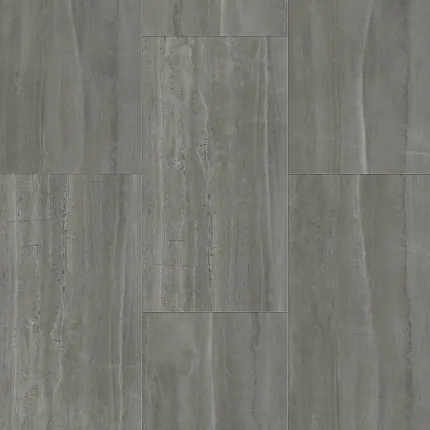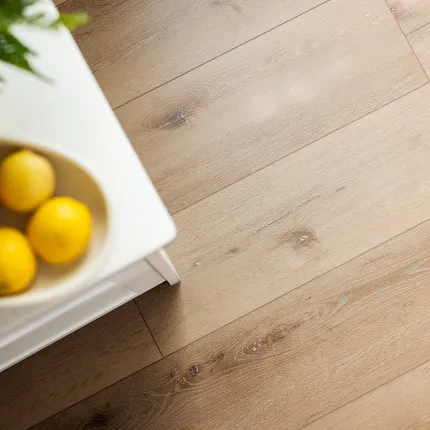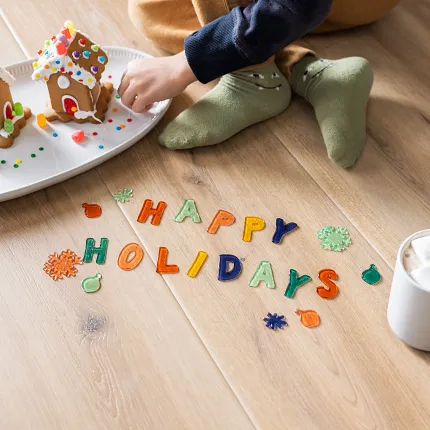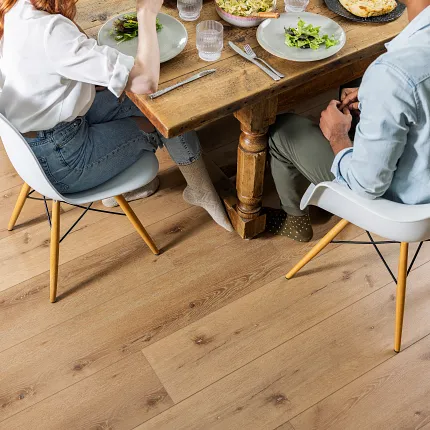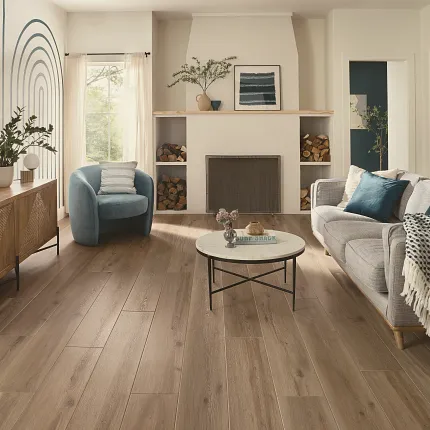October 18, 2024
Table of Contents
Tile flooring is back and bigger than ever. And while porcelain and ceramic are getting all the glitter and glam, a functional substitute – luxury vinyl tile – is gaining popularity for its borderline-authentic look and feel and its ease of installation, maintenance and removal.
Read on for everything you need to know about this increasingly popular floor type.
(Psst. We geeked out a bit on this one. Check the TL;DR section if you're in a hurry.)
Cremello Travertine is the perfect complement to this cozy bedroom.
Booming Tile Popularity
Tile, especially patterned tile, is in right now. Long held hostage by bathrooms and kitchens, experts are predicting (and already seeing) this floor type creep into other rooms of the house.
“The resurgence makes sense,” explains COREtec design director Sarah Gist. “While minimalism was all the craze pre-pandemic, homeowners are now itching to bring life to their spaces, either in the form of dopamine decor or quiet luxury – both trends that tile easily lends itself to.”
In the midst of this resurgence, many are noticing the headaches that come with traditional tile.
- It’s expensive and difficult to install.
- It’s tedious and challenging to clean the easily stainable grout lines.
- It doesn’t take much to chip or crack, which can cause injury to bare feet or paws.
- It’s a hassle and a mess to remove (trends do change, after all).
That’s where luxury vinyl tile (LVT) comes in.
What is LVT?
Luxury vinyl tile, better known as LVT, is comprised of several layers. These floors are designed to look like traditional tile floors (but with some added benefits).
The number of layers and the quality of those layers vary from brand to brand, but usually it looks something like this:
- Finish wear layer: Protects against stains, scuffs and wear.
- Design layer: Dictates the look and feel of the floor.
- Waterproof core: Provides moisture protection and durability
- The COREtec Difference? Our patented waterproof, kidproof, petproof core is thicker, cozier and quieter.
- Underlayment: Additional moisture barrier that goes under the floor and helps with insulation and noise (not always included).
- The COREtec Difference? Every floor we make has a pre-attached underlayment – either our signature cork or our patent-pending Soft Step underlayment that’s 70% quieter, 46% warmer and made from recycled materials.
Collectively, these layers provide the beauty, durability and easy maintenance that homeowners expect from LVT.
The Uncompromising Beauty Of LVT
It’s worth saying again: Tile is beautiful.
And that’s why LVT strives to emulate the look of traditional tile and stone floors. Here’s everything you should know about the beauty of LVT, particularly COREtec LVT:

Bianco Marble whispers quiet luxury.
How LVT Designs Are Created:
LVT uses innovative technology to replicate natural materials, and varying levels of realism can be achieved depending upon the time and intention put into each design. Some LVT manufacturers design their products strictly to hit a certain price point in the market. At COREtec, every floor is made as if it’s going into the designer’s own home.
“Our designers pull inspiration from everywhere, including fashion shows in Europe and exotic trips to Asia. ”
SARAH GIST, director of product design, coretec
“If something sticks out, creation begins. They source visuals that fit the trends they’ve been studying, or sometimes they’ll create the visuals themselves. We’ve had designers on our team lay cement and create terra cottas from scratch.”
Once the visual is selected, it is scanned at an extremely high resolution (your 1080 TV would blush if it saw the number) and then pressed onto planks or tiles. During manufacturing, our teams work hard to ensure proper gloss and clarity levels, so you get the highest level of realism in the final product.
Each of our LVT styles has a unique story.
- Some lean more towards sophistication and elegance.
- Others are more earthy and give feelings of natural restoration.
- Our newest tile styles feature clean square 18” x 18” visuals, including some that were hand-crafted by a COREtec designer.
- And then there’s Vivara Terrazzo – Dopamine Decor’s favorite floor.
REMEMBER: While traditional tile and LVT both last foreverrrrr (Sandlot, anyone?), you may not want them to. If you opt to change your floors in the future, pulling up traditional tile will be a messy challenge.
The Unbelievable Performance Of LVT
When you break it down, LVT floors have essentially added some muscle and simplicity to an already beautiful floor. See what we mean below as we compare traditional tile floors and LVT on:
- Installation
- Ease of maintenance
- Durability

Install and live on COREtec Tile in the same day.
Installations In Hours, Not Days:
Tile is notoriously difficult to install. It’s not good for DIY, and professionals who install it rightly charge a lot of money for their service (it takes a lot of skill and time!).
LVT has a simpler installation story. Here’s why:
- A competent DIYer can easily install these floors (especially if you read this article first).
- If you hire a professional (your retailer can help with this), the price tag will look much better.
- Disruption is minimal (meaning you won’t have to avoid a particular room of your house for days on end).
All in all, installing LVT will save you a lot of money, time and in-home disruption.
Workout-Free Cleaning:
Why is tile so difficult to install and maintain? It’s simple – the grout.
With LVT, grout lines are integrated onto the floors during design. What tangible benefit does this give homeowners?
- A person with a tile floor is going to have to get on their hands and knees and scrub those easily stainable grout lines at least once per month.
- A person with LVT is going to do a quick sweep and mop and go back to relaxing on the couch.
So, essentially, grout is on a mission to steal your time, and LVT is your Clark Kent ready to save the day.
Durability
Just like ceramic dishware, ceramic tiles are made from heated clay. Have you ever chipped a ceramic plate? Didn’t take much, did it?
LVT was made to be chip and crack resistant. Here’s what that means in day-to-day terms: Drop a blow-dryer onto an LVT floor, and it’s not going to break. Try the same with a tile floor and cross your fingers.
Here’s some good news about both floor types: With either, you’ll get 100% waterproof protection.
LVT And Your Well-Being
Did you know your interiors can affect your mood and well-being?
It’s true. Even something as simple as sound abatement can have an outsized impact on your stress levels.
We can’t speak for other LVT brands, but when COREtec creates floors, we keep your well-being and how you live on them top of mind. Here’s how:
- All COREtec floors are GREENGUARD Gold Certified – meaning they’ve met the strictest standards for indoor air quality.
- Our floors excel at sound abatement. Did you know health issues like anxiety and increased heart rate that can result from prolonged exposure to loud decibels?
- COREtec LVT floors are 100% waterproof, helping you combat moisture issues that can lead to mold and mildew in the home.
- Our floors are easy to clean, especially with our vinyl floor cleaner, which makes for an inviting space for both you and your guests.
Want to see how a particular style might look in your space? Use our free online visualizer tool.

Find the right COREtec Tile floor for your home.
TL;DR
Tile floors are beautiful and the “in” floor type right now. They’re also difficult to install and maintain, prone to breaking and notoriously difficult to remove.
Modern LVT looks nearly identical to traditional tile and doesn’t have any of those issues. COREtec LVT floors also feature elements like sound abatement and GREENGUARD Gold certification that can help promote well-being of people and pets in your home.




